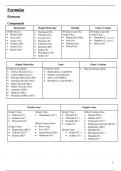Summary
Summary AQA AS Level Physical Chemistry - Unit 3.1.3 - Bonding - Full Notes
- Course
- Institution
Detailed notes for AQA AS level chemistry unit 3.1.3 (bonding). Covers: ionic bonding, metallic bonding, covalent bonding, dative covalent bonding, polarity, electronegativity, trends in electronegativity, bond polarisation, VSEPR theory, shapes of molecules and intermolecular forces. Includes diag...
[Show more]



